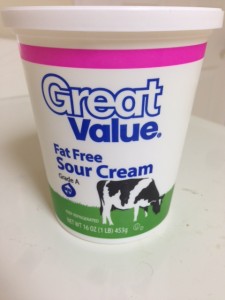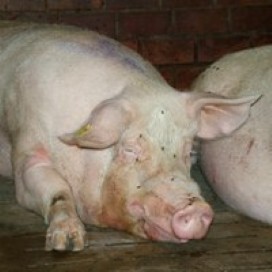 This sour cream container has a picture of a cow grazing on it. The cow is not being anthropomorphized in any way. The cow appears to be healthy and eating fresh grass. This picture makes it seem like the cow used to make the sour cream was given plenty of grass to eat and exercise. The terms “Great Value” and “fat free” also appear on the container.
This sour cream container has a picture of a cow grazing on it. The cow is not being anthropomorphized in any way. The cow appears to be healthy and eating fresh grass. This picture makes it seem like the cow used to make the sour cream was given plenty of grass to eat and exercise. The terms “Great Value” and “fat free” also appear on the container.
I had previously not thought about or even noticed this image on my sour cream before. However, after reading Eating Animals by Jonathan Safran Foer I have begun to see its significance. This image is being used to manipulate the consumer in order to increase market sales. The field of grass in this image extends around the whole container in order for the consumer to imagine that a free-range cow is being used to create this product. According to Foer, “the free-range label is bullshit” (61). The reason that this image would increase market sales is because, as Foer notes, most humans like to imagine that they are eating a “happy” cow due to the fact that most consumers care are ethical and have respect for the animals that they consume. Unfortunately, due to images like the one shown above, they are misinformed. The most access to the outdoors and large green fields that the majority of the cows used to make sour cream get is through a window. Although we would like to think that the cow that aided in the production of the sour cream that ended up on our plates was given access to plenty of food and light, as the cow that is depicted in the picture above is, the truth is that “factory farms commonly manipulate food and light to increase productivity, often at the expense of the animals’ welfare” (Foer 59). The “Great Value” being indicated on this sour cream container points to the low cost of sour cream. However, this low cost is due to increased productivity caused by industrialized farming which Foer would argue is not a great value at all. The term “fat free” is on the container for marketing purposes because many Americans are concerned with becoming overweight. There is a higher obesity rate in America now than ever before due to increased consumption of animal products, which tend to be full of fat. The increase in demand for fat-free foods, like the one shown in the image above, has paralleled the obesity rate. Although this container says that the sour cream is fat free, that does not mean the sour cream suddenly becomes healthy. Instead, the fat often replaced by other substances, such as artificial trans-fats, in order to make the food taste good. These synthetic trans-fats are often more unhealthy than the natural fats that the animal product possesses. Even though this kind of food is unhealthy, it is still produced because our demand for animal food products has “created a food industry whose primary concern isn’t feeding people” (Foer 209). Instead, its primary concern is making as much profit as possible even if it means sacrificing human and animal health.
The reason factory farms do not prioritize animal welfare is because they value animals only in an instrumental sense and not intrinsically. They want as much product as possible for as cheap as possible so that they can increase their profits. In his essay “Why Look at Animals?” John Berger argues that capitalism and the Industrial Revolution are to be blamed for “animals required for food [being] processed like manufactured commodities” (Berger 13).
Treating farm animals well is important because the health of what we eat directly impacts our own health. For example, the epizootic “mad cow disease” was caused by feeding meat and bone meal (MBM) to naturally herbivorous cattle. This disease was spread to humans via the ingestion of products coming from infected cows. Alice Walker comments on this human-animal connection in “Am I Blue?” when she talks about “forgetting”: “People…daily forget, all that animals try to tell us. ‘Everything you do to us will happen to you; we are your teachers, as you are ours. We are one lesson’ ” ( Walker 186). This is why it is important for the public to be informed of the truth about what we put into our mouths. However, truly free-range cattle would decrease profits for many food production companies so they are using images like the one above to trick consumers into thinking they are consuming a product from a free-range cow.
References:
Berger, John. “Why Look at Animals?” About Looking. New York: Pantheon, 1980. 3-28. Print.
“BSE: Disease control & eradication – Causes of BSE”.Department for Environment, Food, and Rural Affairs. July 2009.
Foer, Jonathan Safran. Eating Animals. New York: Little, Brown, 2009. Print.
“The Truth about Low-fat Foods.” BBC Good Food. BBC, n.d. Web. 03 Oct. 2014.
Walker, Alice. “Am I Blue?” Other Nations: Animals in Modern Literature. By Tom Regan and Andrew Linzey. Waco, TX: Baylor UP, 2010. 182-87. Print.


Recent Comments